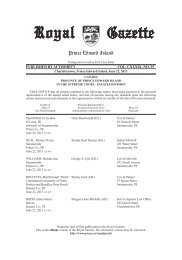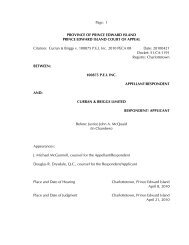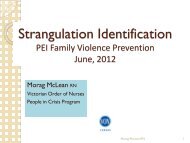PEI Murdered Women 1989 - Government of Prince Edward Island
PEI Murdered Women 1989 - Government of Prince Edward Island
PEI Murdered Women 1989 - Government of Prince Edward Island
Create successful ePaper yourself
Turn your PDF publications into a flip-book with our unique Google optimized e-Paper software.
<strong>PEI</strong> <strong>Murdered</strong> <strong>Women</strong> <strong>1989</strong> - 2009
Introduction<br />
<strong>Women</strong> <strong>Murdered</strong> on <strong>PEI</strong><br />
<strong>1989</strong> - 2009<br />
On December 6, <strong>1989</strong>, fourteen women were murdered at l’École Polytechnique in Montreal.<br />
On <strong>Prince</strong> <strong>Edward</strong> <strong>Island</strong>, just weeks before the Montreal Massacre, a 27-year-old mother <strong>of</strong> three was shot dead<br />
by her estranged husband in Summerside. Since then, seven more women have been murdered by men on P.E.I.<br />
It is important to remember and honour the eight women on P.E.I.<br />
who have lost their lives to male violence since <strong>1989</strong>.<br />
The stories <strong>of</strong> murder are difficult, but in examining the<br />
circumstances <strong>of</strong> their murders we can learn a great deal, perhaps<br />
dispel some myths about violence against women, and hopefully<br />
prevent another murder from happening.<br />
•<br />
•<br />
•<br />
•<br />
•<br />
The murders took place in all three P.E.I. counties and in both<br />
urban and rural areas.<br />
The murder victims ranged in age from 23 to 77.<br />
Two women were murdered by men they were living<br />
with, three by ex-partners, and three by neighbours and<br />
acquaintances.<br />
All <strong>of</strong> the murderers were known to police, all but one for<br />
committing acts <strong>of</strong> violence.<br />
Violence against women can happen at any age, anywhere.<br />
Blue Lady painting by Sandy Kowalik, <strong>PEI</strong><br />
Using court records and media reports, the circumstances surrounding the eight murders are described. Also<br />
included and summarized are some <strong>of</strong> the warning signs <strong>of</strong> potential violence, the legal proceedings, and in some<br />
cases, a follow-up on the <strong>of</strong>fender’s continued involvement with the system. Personal notes about the women have<br />
been added, thanks in large part to the work <strong>of</strong> Eileen LeClair, coordinator <strong>of</strong> UPSE’s Silent Witness project.<br />
These women did not deserve to die. We must all continue to work to prevent any further tragedies.<br />
<strong>Prince</strong> <strong>Edward</strong> <strong>Island</strong> Advisory Council on the Status <strong>of</strong> <strong>Women</strong> - February 2010<br />
Sherwood Business Centre (161 St. Peters Road)<br />
PO Box 2000, Charlottetown, PE C1A 7N8<br />
(902) 368-4510<br />
peistatus<strong>of</strong>women@eastlink.ca<br />
www.gov.pe.ca/acsw<br />
peiacsw.wordpress.com<br />
Page <strong>PEI</strong> Status <strong>of</strong> <strong>Women</strong> 20 0
<strong>PEI</strong> <strong>Murdered</strong> <strong>Women</strong> 989 -<br />
Carrie Ellen (Crossman) McMurrer<br />
April 1962 - October 26, <strong>1989</strong><br />
At approximately 1:50 pm, on October 26,<strong>1989</strong>, Kevin Kenneth McMurrer, walked into Midway Auto in Summerside<br />
where his estranged wife Carrie Ellen McMurrer worked and shot her in the head three times. He was arrested at<br />
approximately 3:20 pm and charged with first-degree murder.<br />
Background<br />
The day McMurrer killed Carrie, he staged a phony car problem in order to get Carrie’s coworker out <strong>of</strong> the<br />
workplace leaving Carrie alone in the Midway Auto <strong>of</strong>fice. He waited a few minutes until her male coworker left<br />
and then walked into the shop carrying a .22 calibre rifle wrapped in a blanket. As Carrie sat at her desk he walked<br />
up to her, shot her, and fled the scene.<br />
Warning signals<br />
•<br />
•<br />
•<br />
•<br />
•<br />
•<br />
Carrie and Kevin had separated, for a second time, in May <strong>1989</strong>. Their three children lived with Carrie. Kevin<br />
fell behind in his support payments, prompting Carrie to limit his visitation rights.<br />
Summerside Police and the RCMP were notified after Kevin assaulted Carrie and created disturbances at her<br />
house.<br />
In July, Kevin was found guilty <strong>of</strong> uttering a threat to kill his wife, fined $500, placed on probation for 18<br />
months, and ordered to avoid contact with Carrie except in relation to visitation <strong>of</strong> the children.<br />
In August, he was admitted to the <strong>Prince</strong> County Hospital following an overdose <strong>of</strong> sleeping pills.<br />
Carrie informed police that on October 4 Kevin borrowed a gun from a friend and that she was very afraid.<br />
He told her he would “blow her f-ing head <strong>of</strong>f.” Although Kevin was found in breach <strong>of</strong> his probation order, he<br />
was not apprehended.<br />
Throughout the fall he turned down work, neglected his child support payments, failed to return the children<br />
on time after visits, and drank heavily.<br />
•<br />
He continued to stalk and threatened to kill Carrie and her father.<br />
Legal proceedings<br />
Kevin McMurrer was found guilty <strong>of</strong> second-degree murder and on July 4, 1990 was given the minimum sentence<br />
<strong>of</strong> life imprisonment with no eligibility for parole for ten years.<br />
Postscript<br />
Immediate community outrage prompted the government to hire retired judge Hon. Charles McQuaid to hold an<br />
inquiry into the handling <strong>of</strong> domestic violence cases by the police and Department <strong>of</strong> Justice.<br />
In 2001, McMurrer was granted full parole. That was revoked in November 2003 after he was convicted <strong>of</strong><br />
assaulting a former girlfriend and possessing stolen property. Both <strong>of</strong>fences took place on P.E.I. during his parole.<br />
In January 2006, McMurrer’s request for both full and day parole was denied. In 2007, he was granted day parole<br />
and it was revoked a year later.<br />
In early 2009, McMurrer was involuntarily transferred from minimum security to medium-security after stealing<br />
money from the inmate canteen while working as the canteen operator, a job he held for two months. A<br />
psychological report completed in May 2009 indicates he presented a moderate risk <strong>of</strong> re-<strong>of</strong>fending and was at a<br />
high risk <strong>of</strong> “re-<strong>of</strong>fending in a domestic context.”<br />
Sources<br />
Sources used are public documents including <strong>PEI</strong> Supreme Court transcripts R vs McMurrer (1990); Hon. Charles R. McQuaid,<br />
Inquiry into Police and Dept. <strong>of</strong> Justice Policies and Procedures in Cases <strong>of</strong> Inter-Spousal and Intra-Family Violence, (November<br />
15, 1991); Journal-Pioneer and Guardian newspaper reports (<strong>1989</strong> – 1990 and 2007 -2009); UPSE Silent Witness project.<br />
Page 2
On April 7, 1991, 36-year old Elaine Myers was found murdered in her bed. She had been stabbed multiple times in<br />
the chest, and her throat had been slashed with a kitchen knife.<br />
Background<br />
Roger Lee Burke, age 37, Elaine’s downstairs neighbour and acquaintance, was charged with second-degree murder<br />
and pleaded not guilty at the pre-trail. He later changed his plea to guilty and elected to be tried by judge alone.<br />
Although Burke testified he couldn’t remember the murder, the sole account <strong>of</strong> the events <strong>of</strong> that April day at the<br />
Valdane Avenue apartment in Sherwood came from Roger Burke.<br />
His account <strong>of</strong> what happened the night Elaine was murdered was accepted by the judge. He spoke about Elaine<br />
asking him over to her place and <strong>of</strong>fering wine. Burke and Elaine consumed two quarts <strong>of</strong> wine and then he<br />
returned to his own apartment.<br />
Several hours later, around 9 a.m., he went back to Elaine’s apartment. Burke alleged that following an argument<br />
about his sexual prowess, Elaine infuriated him by saying he wasn’t “man enough” to have sex with her. He went<br />
back to his apartment, got a paring knife and went back to Elaine’s apartment, where he found her in bed. He<br />
stabbed her in the chest and slit her throat.<br />
He went back to his place, stripped <strong>of</strong>f his clothing, and soaked them to remove the blood. He stuffed the clothes in<br />
a bag and dumped them in a culvert. He then buried the knife.<br />
Warning signals<br />
•<br />
•<br />
Elaine Edith (Meney) Myers<br />
1955 – April 7, 1991<br />
Burke suffered from depression, personality disorder and multiple drug and alcohol abuse.<br />
According to Dr. Pamela Forsythe’s testimony, Burke had a long psychiatric history, having been admitted to<br />
the Hillsborough Hospital 41 times.<br />
• Burke had married in the fall <strong>of</strong> 1990 and within months was charged for threatening to kill his wife and was<br />
given a restraining order. They separated early in 1991.<br />
Legal proceedings<br />
Burke pleaded “not guilty” at his pre-trial in June 1991. In December he elected to be tried by judge alone<br />
and changed his plea to guilty <strong>of</strong> second-degree murder. The presiding judge and defense lawyer cited Burke’s<br />
intoxication and Elaine’s sexual taunts as mitigating factors in the murder. He was sentenced to life in prison with<br />
eligibility for parole after 10 years.<br />
Notes<br />
Elaine “Lainy” grew up in Little Sands, <strong>PEI</strong> and was a talented musician who loved to play guitar and sing. She was<br />
remembered by her step-sister as a caring person who “loved everybody…she wouldn’t hurt a fly.”<br />
Sources<br />
Sources used are public documents and include <strong>PEI</strong> Supreme Court transcripts R vs Burke (1991); Journal-Pioneer and Guardian<br />
newspaper reports (1991); UPSE Silent Witness Project.<br />
Page <strong>PEI</strong> Status <strong>of</strong> <strong>Women</strong> 20 0
On October 7, 1994, Shirley Ann Duguay’s abandoned car was found in a field on Highway 169, near Tyne Valley.<br />
Shirley was last seen on October 3, 1994. RCMP did a large search <strong>of</strong> the area, using 120 members <strong>of</strong> CFB<br />
Gagetown and students from the Atlantic Police Academy. The search was called <strong>of</strong>f as winter moved in.<br />
On May 6, 1995, Shirley’s battered and partially decomposed body was discovered in a shallow grave in a wooded<br />
area <strong>of</strong> North Enmore. Her hands were tied behind her back and she had been strangled.<br />
Background<br />
Douglas Leo Beamish, Shirley’s estranged husband, was the primary suspect in Shirley’s disappearance. Foul play<br />
was suspected from the start but without a body, it was difficult to investigate. RCMP found a plastic bag near the<br />
body containing a leather jacket with bloodstains and two strands <strong>of</strong> white hair. The blood proved to be Shirley’s<br />
and the hair was from Snowball, a cat belonging to Beamish’s parents. Douglas Beamish was staying with his<br />
parents at the time <strong>of</strong> Shirley’s disappearance.<br />
Warning signals<br />
•<br />
•<br />
Beamish was known to police for his violent behaviour both in Toronto and <strong>PEI</strong>. Toronto Metro Police served<br />
him with a peace bond in 1991 and Shirley returned to the <strong>Island</strong> to get away from him.<br />
During the trial, evidence in the form <strong>of</strong> a letter (written during a separation in 1992), revealed his state <strong>of</strong><br />
mind. In the letter, Beamish wrote that if he couldn’t be with Shirley he would kill her, their three children<br />
and himself.<br />
• It was also revealed at trial that Beamish had a history <strong>of</strong> violence towards women. His former common-law<br />
spouse described an incident in the mid-1980s, in which she was beaten, raped and threatened death at<br />
knifepoint in front <strong>of</strong> her children.<br />
Legal proceedings<br />
The introduction <strong>of</strong> Snowball’s hair as evidence was the world’s first use <strong>of</strong> non-human DNA in a criminal trial.<br />
Douglas Beamish was charged with first-degree murder and found guilty <strong>of</strong> second-degree. He was sentenced to<br />
life in prison with no possibility <strong>of</strong> parole for 18 years.<br />
Postscript<br />
Beamish appealed his conviction in 1998 and 1999. Both appeals were rejected.<br />
Notes<br />
Shirley was the mother <strong>of</strong> five children (two from a relationship prior to Beamish). Shirley’s daughter Shelley<br />
has grown up to become a passionate advocate <strong>of</strong> abused women, publically sharing her experiences as a child<br />
witnessing violence and keeping her mother’s memory alive.<br />
Sources<br />
Sources used are public documents and include <strong>PEI</strong> Supreme Court transcripts R vs Beamish (1996, 1998, 1999); Journal-Pioneer<br />
and Guardian newspaper reports (1994 –2000); New York Times (1997); UPSE Silent Witness Project.<br />
<strong>PEI</strong> <strong>Murdered</strong> <strong>Women</strong> 989 -<br />
Shirley Ann Duguay<br />
Oct.11, 1961 - Oct. 3, 1994 (last seen)<br />
Page
On the morning <strong>of</strong> August 18, 1998, 77 year-old Della Waddell was found murdered in her Alexander Drive<br />
bungalow in Charlottetown. She had been bludgeoned by a vacuum cleaner and stabbed 62 times.<br />
Background<br />
Edmond John Aylward, age 21, was charged with first-degree murder. His fingerprint and palm print were found in<br />
Della’s house and a kit bag containing both his ID and Della’s was located in a Charlottetown park. Aylward knew<br />
Della, having grown up in the neighbourhood. He never said why he murdered Della. According to his lawyer at the<br />
trial, Aylward “can’t answer why he committed such a crime.”<br />
Warning signals<br />
•<br />
•<br />
Della Waddell<br />
1921 – August 18, 1998<br />
In 1994, Aylward assaulted a 77 year-old women with a broom handle.<br />
Aylward, the youngest <strong>of</strong> six children, was involved with the system from a young age, first with Child and<br />
Family Services, then with Mental Health after a suicide attempt at age eighteen.<br />
• In 1996, he started a fire by putting eight aerosol cans in a microwave, causing $25,000 in damages.<br />
Probation Services and Corrections became involved.<br />
Legal proceedings<br />
Aylward pleaded not guilty to first-degree murder but a week into his trial he changed his plea to guilty <strong>of</strong> seconddegree<br />
murder. He was sentenced to life in prison with no chance <strong>of</strong> parole for 15 years. For the first time in <strong>PEI</strong><br />
courts, family members were allowed to read their victim impact statements at sentencing.<br />
Notes<br />
Della, a widow living alone, was a slight 120 pounds and severely arthritic. The victim impact statements painted a<br />
picture <strong>of</strong> a dearly loved mother, grandmother, and great grandmother; a retired nurse caring for her cat, feeding<br />
the birds, and telling jokes. Della was a passionate Blue Jays baseball fan and a bingo enthusiast.<br />
“She didn’t die peacefully, so we have to live with that for the rest <strong>of</strong> our lives,” commented her grandson at the<br />
sentencing. “I don’t know if we’ll ever be okay.”<br />
Sources<br />
Sources used are public documents and include <strong>PEI</strong> Supreme Court transcripts R vs Aylward (1999); CBC News (1998–2000);<br />
Journal-Pioneer and Guardian newspaper reports (1998 –2000); UPSE Silent Witness Project.<br />
Page <strong>PEI</strong> Status <strong>of</strong> <strong>Women</strong> 20 0
In the early morning hours <strong>of</strong> Sunday, August 13, 2000, police responded to a 911 call and found 45 year-old Mary<br />
Waite dead in the bathroom <strong>of</strong> her Carvell Street apartment in Summerside. She had been beaten to death. Mary<br />
suffered multiple blows to the head, neck, trunk, and extremities and died from blunt force trauma to the head and<br />
neck. Several days later, John William Fennell, Mary’s estranged common-law partner was charged with first-degree<br />
murder.<br />
Background<br />
Around 1 a.m. on August 13, after a heavy night <strong>of</strong> drinking, an argument broke out and Fennell attacked Mary.<br />
Blood markings indicated that the assault took place around the apartment. After the assault Fennell left the<br />
apartment and went to a neighbour’s, where he sat and rolled cigarettes, his demeanor apparently appearing<br />
“normal.” After about an hour and a half he went back to the apartment where he indicated that he found Mary<br />
dead on the bathroom floor. He called 911 and tried to clean up the blood.<br />
Warning signals<br />
•<br />
•<br />
•<br />
Mary was no stranger to violence in her relationships with male partners. Mary’s first partner, John Garfield<br />
Waite, and father <strong>of</strong> her three children was violent towards her during their marriage.<br />
Mary had endured five years <strong>of</strong> punches, kicks and verbal threats at the hands <strong>of</strong> John Fennell.<br />
After a severe beating in August 1999 and again in November, Fennell was convicted <strong>of</strong> assault, served two<br />
months, was put on probation, and ordered to stay away from Mary.<br />
• Mary, having no place to live, moved back in with Fennell despite the efforts <strong>of</strong> family, police and probation<br />
<strong>of</strong>ficers to intervene.<br />
Legal proceedings<br />
On March 5, 2001, Fennell waived his right to a preliminary inquiry and his case was sent directly to the Supreme<br />
Court <strong>of</strong> <strong>PEI</strong>. The charge was reduced to second-degree murder and did not go to trial. Fennell pleaded guilty to<br />
manslaughter and was sentenced to 14 years in a federal penitentiary.<br />
Notes<br />
Ironically, a year before Mary’s murder, her ex-husband was murdered by his common-law wife Julie Cavell Hynes.<br />
In May 1999 Julie hit him on the head with a marble rolling pin while he slept in their East Bideford house. Julie<br />
pleaded guilty to second-degree murder and received a life sentence.<br />
Sources<br />
Sources used are public documents and include <strong>PEI</strong> Supreme Court transcripts R vs Fennel (2001); Journal-Pioneer and Guardian<br />
newspaper reports (2000 - 2001); UPSE Silent Witness Project.<br />
<strong>PEI</strong> <strong>Murdered</strong> <strong>Women</strong> 989 -<br />
Mary Elizabeth Waite<br />
1955 - August 13, 2000<br />
Page
During the early morning hours <strong>of</strong> December 10, 2000, 30 year-old Kimberly Ann Byrne was beaten to death in her<br />
Cardigan home by her common-law spouse Frederick Francis Sheppard.<br />
Background<br />
Sheppard had been drinking with a friend on Saturday, December 9. Kim and their son, seven year-old Cuyler<br />
arrived at the friend’s place late afternoon. Kim joined the men in drinking while Cuyler watched movies. An<br />
argument between Kim and Sheppard broke out around 10 – 11 p.m., when he shoved her and grabbed her by the<br />
hair. Their friend broke it up and Kim left for home with her son, refusing to let Sheppard in the car. He began to<br />
walk the two kilometers home.<br />
The friend called Kim to warn her that Sheppard was very angry and that she should leave. She went back to the<br />
friend’s place, telling him that she planned to leave Sheppard right after Christmas. Although the friend tried to<br />
persuade her to stay for the night, she went home around 2 a.m.<br />
When she got back home Sheppard was there and they began to argue. Cuyler witnessed his father giving his<br />
mother a bloody nose and kicking her while she was on the floor. Culyer fled to his bedroom where he cried and<br />
covered his ears so he would not hear the “thumping and screaming and bad words” his father was saying.<br />
Following the attack, Sheppard left and went to a friend’s home looking for liquor. He told his friend that he had<br />
beaten Kim and that he planned to go after the man who he thought she was having an affair. He reported that<br />
he returned home and found Kim in a pool <strong>of</strong> blood and not breathing. He said he attempted mouth-to-mouth<br />
resuscitation. At 5:42 a.m. he called 911. When the paramedics arrived at 5:55, Kim had no vital signs.<br />
Legal proceedings<br />
Sheppard was charged with second-degree murder. His plea-bargain to the lesser charge <strong>of</strong> manslaughter sparked<br />
public demonstrations <strong>of</strong> protest. Weekly vigils were held at the courthouse in Charlottetown and over 2,600<br />
<strong>Island</strong>ers signed petitions asking that Fred Sheppard receive a life sentence with no chance for parole. He was<br />
sentenced to 10 years imprisonment in May 2001, with eligibility for parole after three years.<br />
Warning signals<br />
•<br />
Kimberly Ann Byrne<br />
November 1, 1970 – December 10, 2000<br />
Sheppard was known in the community and to police as someone who abused alcohol.<br />
• Sheppard threatened to kill the person he thought was having an affair with Kimberly.<br />
Postscript<br />
Following the Sheppard decision, the <strong>PEI</strong> government held public and private consultations across the province<br />
to develop a family violence strategy that was implemented through the Premier’s Action Committee on Family<br />
Violence. A key component <strong>of</strong> the strategy is awareness, education and training in the area <strong>of</strong> domestic violence.<br />
In January 2004 Sheppard was granted 3 day leaves. In July 2004 he was granted day parole. In July 2005 he was<br />
caught drinking alcohol (a parole violation) but kept day parole. His parole was revoked in August 2005 when he<br />
didn’t return to his halfway house. In January 2008 he was given 6 months day parole.<br />
In August 2008, Sheppard was ordered returned to a minimum to medium-security correctional facility in Alberta.<br />
The incident that led to this penalty was an altercation that occurred after Sheppard harassed a woman on the<br />
street. Police arrived on the scene and told Sheppard to leave the woman alone.Sheppard, who was drinking,<br />
yelled at the police and then tried to punch one <strong>of</strong> the <strong>of</strong>ficers in the head.<br />
Notes<br />
As a licensed practical nurse, Kimberly was a member <strong>of</strong> the <strong>PEI</strong> Union <strong>of</strong> Public Sector Employees (UPSE). In<br />
December <strong>of</strong> 2004 family, friends and co-workers constructed a life-sized wooden “silhouette” <strong>of</strong> Kimberly, through<br />
the “Silent Witness” project. This Minnesota project commemorates women who have been killed by their partners<br />
or ex-partners. UPSE sponsored Kimberly’s silhouette, the first on <strong>PEI</strong>.<br />
Sources<br />
Sources used are public documents and include <strong>PEI</strong> Supreme Court transcripts R vs Sheppard (2001); CBC News (2000-2009);<br />
Journal-Pioneer and Guardian newspaper reports (2000 –2009); UPSE Silent Witness Project.<br />
Page <strong>PEI</strong> Status <strong>of</strong> <strong>Women</strong> 20 0
In the early morning <strong>of</strong> July 1, 2001, 46 year-old Deborah Holmes was murdered. James Barry Bradley, her ex-spouse<br />
used an axe to smash his way into her apartment building and then into her apartment. He hacked her to death.<br />
Background<br />
On the morning <strong>of</strong> the murder, Barry Bradley called Debbie’s residence five times. At approximately 5 a.m., Barry drove<br />
to Debbie’s apartment building and began pressing the buzzer to her apartment. Debbie called 911. RCMP arrived at<br />
Debbie’s apartment within 15 minutes, but Bradley had fled.<br />
While the police were there, Bradley again telephoned Debbie. The police answered the phone and challenged<br />
Bradley’s presence earlier at Debbie’s apartment. Bradley explained that his “stay-away order” had recently expired<br />
and he was allowed to be there. He told the police that he wanted to see his daughter. Police left Debbie’s apartment<br />
but did not go to Bradley’s residence or apprehend him.<br />
Approximately 90 minutes after Bradley’s telephone conversation with the police at Deborah’s apartment, Bradley<br />
drove to the apartment and smashed his way into the building using an axe and carrying a hatchet. The first <strong>of</strong> several<br />
911 calls came in at 6:42:23 a.m.<br />
Police entered the apartment building within two to three minutes after receiving the call and found Bradley standing<br />
in the hall with blood on his clothing. EMTs arrived but Debbie did not exhibit vital signs. The coroner pronounced her<br />
dead at the scene. Among other injuries, Debbie suffered four chop wounds to her neck and six lacerations to her head<br />
and neck. Her spinal cord was severed.<br />
Warning signals<br />
•<br />
•<br />
Debbie endured over 25 years <strong>of</strong> violence from her common-law spouse, James Barry Bradley. She left many<br />
times but Bradley would convince her to return. In 1998, she left for good but the threats and violence<br />
continued. Bradley told many people that he owned her and if she didn’t return to him he would kill her.<br />
There were seven occasions between 1998 and 2001 in which Debbie Holmes called the police or 911 to report<br />
that Bradley had breached the stay-away order. On April 1, 1999, Barry was placed on probation and<br />
ordered to stay away from Debbie's residence for one year.<br />
• He also harassed her at her workplace, calling her constantly, driving slowly by or just dropping in, and<br />
threatening co-workers in spite <strong>of</strong> a “no trespass” order.<br />
Legal proceedings<br />
In March 2003, James Barry Bradley was found guilty <strong>of</strong> first-degree murder in the death <strong>of</strong> Debbie Holmes. The<br />
decision made legal history in two ways. This was the first conviction in Canada <strong>of</strong> first-degree murder on the<br />
grounds <strong>of</strong> stalking a victim (Stalking became grounds for a first-degree murder finding in 1997). This was also the<br />
first conviction for first-degree murder in <strong>Prince</strong> <strong>Edward</strong> <strong>Island</strong>. No one had been convicted <strong>of</strong> first-degree murder on<br />
<strong>PEI</strong> since the law was changed from the older crime <strong>of</strong> “capital murder” in the 1970s. Bradley was sentenced to life<br />
imprisonment (no parole for 25 years).<br />
Postscript<br />
Bradley appealed the verdict in May 2004. His appeal was postponed until December 2004 when a legal aid lawyer was<br />
appointed. In September 2006 his legal aid lawyer asked to be removed. The appeal was dismissed.<br />
Notes<br />
Debbie was a mother <strong>of</strong> two, a friend to many, and a long-time employee <strong>of</strong> the <strong>PEI</strong> Native Council. According to a<br />
friend’s testimony at Barry’s murder trial, “Debbie was concerned every minute <strong>of</strong> her life that I knew her. Debbie was<br />
always trying to appease Barry, and she did it in a manner that was just part <strong>of</strong> her life. She had to do it to survive. She<br />
told me quite plainly that Barry was going to kill her...”<br />
Sources<br />
Sources used are public documents and include <strong>PEI</strong> Supreme Court transcripts R vs Bradley (2003, 2004, 2007; CBC News (2001-<br />
2007); Journal-Pioneer and Guardian newspaper reports (2001 – 2007); UPSE Silent Witness Project.<br />
<strong>PEI</strong> <strong>Murdered</strong> <strong>Women</strong> 989 -<br />
Deborah Holmes<br />
1955 – July 1, 2001<br />
Page 8
Chrystal Dawn Bearisto<br />
October 15, 1979 – July 28, 2002<br />
Chrystal Dawn Bearisto <strong>of</strong> Charlottetown was riding her bike, on her way to visit with her son on the Saturday<br />
afternoon <strong>of</strong> July 27, 2002. The next day her battered body was found in a wooded area just <strong>of</strong>f the Confederation<br />
Trail, near the Community Gardens on Mount <strong>Edward</strong> Road. Chrystal’s hands were tied behind her back and she<br />
was naked below the waist. She had been raped, strangled and stabbed multiple times.<br />
Background<br />
On that Saturday afternoon, Chrystal rode her mountain bike up the trail to Wal-Mart to visit her partner Albert<br />
MacKenzie during his work break. Around 4 p.m. he went back to work and she left on her bike to go see her son.<br />
She never made it.<br />
For years, Chrystal’s boyfriend MacKenzie was the focus <strong>of</strong> the police investigation but there was no evidence to<br />
prove he had committed the crime.<br />
In 2005, John David Rayner was found guilty <strong>of</strong> sexual exploitation and his DNA went into the National DNA<br />
Databank. Police were able to match DNA found at the scene <strong>of</strong> Chrystal’s murder to Rayner’s. As well as the DNA,<br />
fingerprints and other circumstantial evidence linked Rayner, an acquaintance <strong>of</strong> Chrystal’s, to the crime. He was<br />
charged with the murder in December 2005.<br />
Warning signals<br />
Rayner is formerly from Charlottetown, but police picked him up after he was released from a detention centre in<br />
Toronto. He had just completed a prison term for sexual exploitation.<br />
Legal proceedings<br />
John David Rayner, 43, was found guilty <strong>of</strong> first-degree murder in June 2007. He was sentenced to life imprisonment<br />
with no possibility <strong>of</strong> parole for 25 years.<br />
No motive was given at the trial and he maintained his innocence.<br />
Notes<br />
Chrystal worked in the mailroom <strong>of</strong> the Guardian newspaper <strong>of</strong>fice and had recently returned to school, earning<br />
her high school diploma.<br />
Sources<br />
Sources used are public documents and include <strong>PEI</strong> Supreme Court transcripts R vs Rayner (2007); CBC News (2002-2007);<br />
Journal-Pioneer and Guardian newspaper reports (2002 -2007); UPSE Silent Witness Project.<br />
Page 9 <strong>PEI</strong> Status <strong>of</strong> <strong>Women</strong> 20 0

















